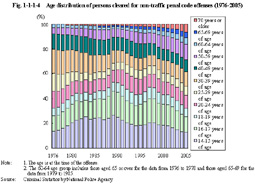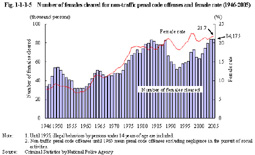| Previous Next Index Image Index Year Selection | |
|
|
2 Persons cleared
The number of persons cleared for penal code offenses exceeded one million for the first time in 27 years in 1998, and had continued hitting a new post WWII high every year from 1999 to 2004, but decreased by 10,937 (0.8%) from the previous year in 2005.
Table 1-1-1-2 shows the number of persons cleared in 2005 by type of offense and Fig. 1-1-1-3 [2] shows the percent ratio by type of offense. The percent ratio was the highest for negligence in the pursuit of social activities in traffic accidents at nearly 70%, followed by theft, embezzlement, and injury. Fig. 1-1-1-4 shows the age distribution of persons cleared for non-traffic penal code offenses over the last 30 years. The share of those aged 60 or over has increased from 2.8% in 1976 to 16.3% in 2005. The share of those aged 65 or over was 10.9% in 2005. Fig. 1-1-1-4 Age distribution of persons cleared for non-traffic penal code offenses (1976-2005) Fig. 1-1-1-5 shows the number of females cleared for non-traffic penal code offenses and the female rate since 1946.The number of females cleared reached peaks in 1950, 1964, and 1983, and then decreased from 1989. However, it started to increase again after hitting the bottom at the range of 52,000 in 1992 and was 84,175 in 2005 (up by 43 persons (0.1%) from the previous year). The female rate was on an upward trend since 1946 and exceeded 20% for the first time in 1988. It has been around 20% and was 21.7% in 2005 (up by 0.1 point from the previous year). Female cleared rate per 100,000 population aged 14 or over for non-traffic penal code offenses had been between 100 and 130 since 1989, but has been on an upward trend since 2001 and was 145.8 (down by 0.8% from the previous year) in 2005. Fig. 1-1-1-5 Number of females cleared for non-traffic penal code offenses and female rate (1946-2005) Table 1-1-1-6 shows the number of females cleared for non-traffic penal code offenses in 2005, by type of offense.In 2005, females cleared for theft accounted for the majority, followed by embezzlement and injury. More specifically, more than 80% of those cleared for theft committed shoplifting and most of those cleared for embezzlement committed embezzlement of lost property. The female rate was high for infanticide in homicide (94.7%) and shoplifting in theft (44.1%). The juvenile rate in all females cleared for non-traffic penal code offenses was extremely high for extortion (63.1%). Table 1-1-1-6 Number of females cleared for non-traffic penal code offenses, by type of offense (2005) |


